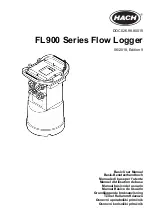
Section 8. Operation
412
8.1.2.4 Auto Self-Calibration — Details
Related Topics
•
Auto Self-Calibration — Overview
(p. 99)
•
Auto Self-Calibration — Details
(p. 412)
•
Auto Self-Calibration — Errors
(p. 565)
•
Offset Voltage Compensation
(p. 397)
•
Factory Calibration
(p. 96)
•
Factory Calibration or Repair Procedure
(p. 550)
The CR6 auto self-calibrates to compensate for changes caused by changing
operating temperatures and aging. Disable auto self-calibration when it interferes
with execution of very fast programs and less accuracy can be tolerated.
With auto self-calibration disabled, measurement accuracy over the operational
temperature range is specified as less accurate by a factor of 10. If the
temperature of the CR6 remains the same, there is little calibration drift if
auto-calibration is disabled. Auto self-calibration can become disabled when the
scan rate is too small. It can be disabled by the CRBasic program when using the
Calibrate()
instruction.
Note
The CR6 is equipped with an internal voltage reference used for
calibration. The voltage reference should be periodically checked and
re-calibrated by Campbell Scientific for applications with critical analog
voltage measurement requirements. A minimum three-year recalibration
cycle is recommended.
Unless a
Calibrate()
instruction is present, the CR6 auto self-calibrates once each
minute as a
slow sequence
(p. 216).
If there is insufficient time to do the auto
self-calibration because of a scan-consuming user program, the CR6 will display
the following warning at compile time:
Warning: Background calibration is
disabled
.
8.1.2.4.1 Auto Self-Calibration Process
Auto self-calibration can be overridden with the
Calibrate()
instruction, which
forces a calibration for each execution, and does not employ low-pass filtering on
the newly determined G and B values. The
Calibrate()
instruction has two
parameters:
CalRange
and
Dest
.
CalRange
determines whether to calibrate only
the necessary input ranges for a given CRBasic program (
CalRange
= 0) or to
calibrate all input ranges (
CalRange
≠ 0). The
Dest
parameter should be of
sufficient dimension for all returned G and B values, which is a minimum of two
for the auto self-calibration of
VoltSE()
including B (offset) for the ±5000 mV
input range with first 15000
fN1
, and a maximum of 27 for all input-voltage
ranges used and key
fN1
(p. 584)
values selected by the operating system.
An example use of the
Calibrate()
instruction programmed to calibrate all input
ranges is given in the following CRBasic code snip:
'Calibrate(Dest,Range)
Calibrate
(cal(1),true)
Summary of Contents for CR6 Series
Page 2: ......
Page 4: ......
Page 6: ......
Page 32: ......
Page 36: ......
Page 38: ......
Page 76: ...Section 5 Overview 76 FIGURE 20 Half Bridge Wiring Example Wind Vane Potentiometer ...
Page 80: ...Section 5 Overview 80 FIGURE 23 Pulse Input Wiring Example Anemometer ...
Page 136: ......
Page 454: ...Section 8 Operation 454 FIGURE 104 Narrow Sweep High Noise ...
Page 459: ...Section 8 Operation 459 FIGURE 106 Vibrating Wire Sensor Calibration Report ...
Page 535: ...Section 8 Operation 535 8 11 2 Data Display FIGURE 121 CR1000KD Displaying Data ...
Page 537: ...Section 8 Operation 537 FIGURE 123 CR1000KD Real Time Custom ...
Page 538: ...Section 8 Operation 538 8 11 2 3 Final Storage Data FIGURE 124 CR1000KD Final Storage Data ...
Page 539: ...Section 8 Operation 539 8 11 3 Run Stop Program FIGURE 125 CR1000KD Run Stop Program ...
Page 541: ...Section 8 Operation 541 FIGURE 127 CR1000KD File Edit ...
Page 546: ......
Page 552: ......
Page 610: ...Section 11 Glossary 610 FIGURE 137 Relationships of Accuracy Precision and Resolution ...
Page 612: ......
Page 648: ......
Page 650: ......
Page 688: ......
Page 689: ......
















































